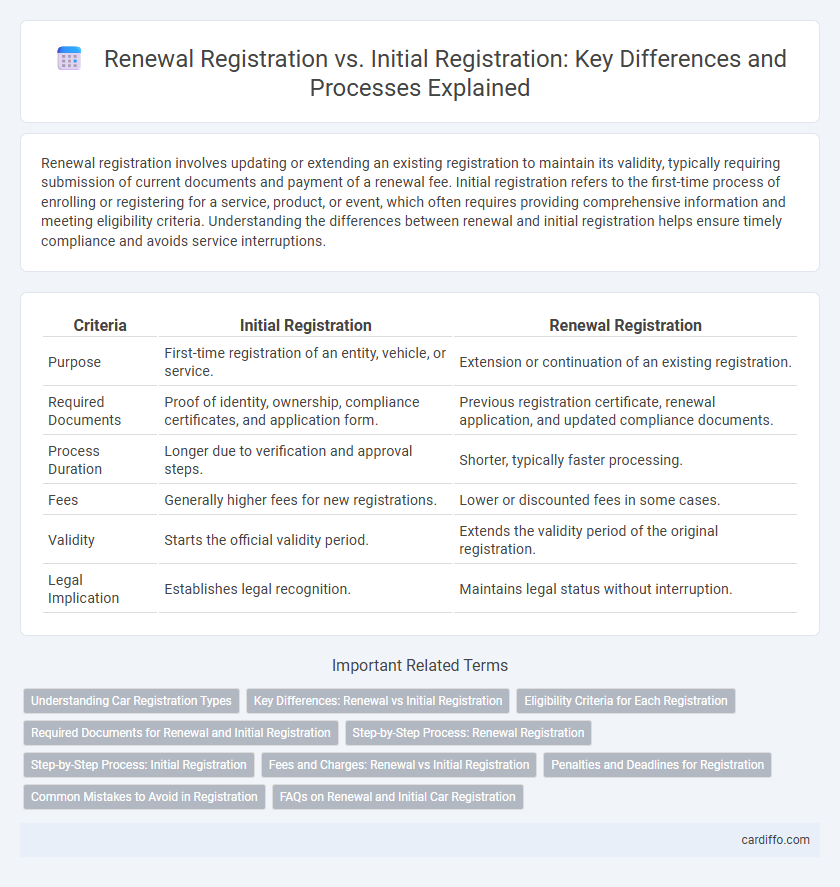Renewal registration involves updating or extending an existing registration to maintain its validity, typically requiring submission of current documents and payment of a renewal fee. Initial registration refers to the first-time process of enrolling or registering for a service, product, or event, which often requires providing comprehensive information and meeting eligibility criteria. Understanding the differences between renewal and initial registration helps ensure timely compliance and avoids service interruptions.
Table of Comparison
| Criteria | Initial Registration | Renewal Registration |
|---|---|---|
| Purpose | First-time registration of an entity, vehicle, or service. | Extension or continuation of an existing registration. |
| Required Documents | Proof of identity, ownership, compliance certificates, and application form. | Previous registration certificate, renewal application, and updated compliance documents. |
| Process Duration | Longer due to verification and approval steps. | Shorter, typically faster processing. |
| Fees | Generally higher fees for new registrations. | Lower or discounted fees in some cases. |
| Validity | Starts the official validity period. | Extends the validity period of the original registration. |
| Legal Implication | Establishes legal recognition. | Maintains legal status without interruption. |
Understanding Car Registration Types
Renewal registration involves updating existing vehicle records annually to maintain legal driving status, while initial registration refers to the first-time process of entering a vehicle into the official database. Initial registration requires submitting proof of ownership, identification, and payment of applicable fees, whereas renewal registration typically involves verifying insurance and paying a renewal fee. Understanding the distinction between these registration types ensures compliance with state laws and helps avoid penalties related to expired vehicle registration.
Key Differences: Renewal vs Initial Registration
Renewal registration requires verifying and updating existing information to maintain active status, whereas initial registration involves submitting complete new details and documents for first-time approval. Renewal processes typically follow a streamlined verification path, focusing on changes since the last registration, while initial registration demands comprehensive evaluation and approval. Timelines differ significantly, with initial registration often taking longer due to full processing requirements compared to faster renewal procedures.
Eligibility Criteria for Each Registration
Eligibility criteria for initial registration typically include first-time applicants providing proof of identity, residency, and compliance with specific regulatory requirements. Renewal registration requires that the applicant has a valid existing registration and meets ongoing compliance standards such as updated documentation or fee payments. Both processes necessitate verification of eligibility, but initial registration demands more comprehensive documentation, while renewal focuses on maintaining active status.
Required Documents for Renewal and Initial Registration
Renewal registration requires documents such as the current registration certificate, proof of identity, and payment of applicable fees, ensuring continuity without submission of original ownership documents. Initial registration demands comprehensive proof including original ownership documents, proof of insurance, valid identification, and sometimes emissions compliance certificates. Both processes prioritize accurate verification, but initial registration involves more extensive documentation to establish legal ownership and vehicle history.
Step-by-Step Process: Renewal Registration
Renewal registration involves submitting an updated application, verifying existing information, and paying the applicable renewal fees within the designated timeframe to maintain active status. The process requires reviewing current details for accuracy, uploading any necessary supporting documents, and confirming compliance with regulatory requirements. Successful completion ensures uninterrupted access to services and adherence to legal obligations.
Step-by-Step Process: Initial Registration
The initial registration process involves completing an application form, submitting required identification documents, and paying the designated registration fee. Applicants must verify their eligibility and provide proof of residency or ownership as part of the registration protocol. Finalizing initial registration grants access to official records and enables participation in related services and benefits.
Fees and Charges: Renewal vs Initial Registration
Renewal registration fees are typically lower than initial registration fees, reflecting the reduced administrative effort and validation required. Initial registration often involves higher charges due to comprehensive documentation verification and system setup processes. Understanding the fee structure helps registrants budget appropriately and avoid unexpected costs during both registration stages.
Penalties and Deadlines for Registration
Renewal registration typically requires timely submission before the expiration date to avoid penalties such as late fees or suspension of privileges, whereas initial registration mandates strict adherence to deadlines often accompanied by initial setup fees and mandatory documentation. Penalties for late renewal can include fines and possible service disruptions, while failure to complete initial registration on time may result in denial of access or legal constraints. Both processes emphasize meeting deadlines to maintain compliance and prevent costly penalties.
Common Mistakes to Avoid in Registration
Renewal registration often gets delayed due to expired documents or incorrect fee submissions, while initial registration commonly faces issues like incomplete application forms and lack of required identification. Avoiding these mistakes requires careful verification of all documents and adherence to the specific guidelines set by the registration authority. Ensuring timely submission and double-checking details can prevent rejection and processing delays in both renewal and initial registration processes.
FAQs on Renewal and Initial Car Registration
Renewal registration requires updating vehicle information and paying fees before the current registration expires, while initial registration involves submitting ownership documents and obtaining new license plates. Common FAQs about renewal include how early it can be completed, acceptable payment methods, and penalties for late renewal. Initial registration FAQs often cover document requirements, inspection procedures, and the timeline for receiving registration materials.
Renewal Registration vs Initial Registration Infographic

 cardiffo.com
cardiffo.com